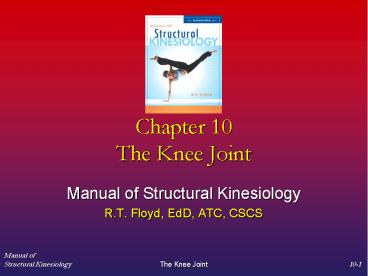Manual of Structural Kinesiology - PowerPoint PPT Presentation
Title:
Manual of Structural Kinesiology
Description:
... Kinesiology The Knee Joint 10-* Bones Enlarged femoral condyles articulate ... with femur or patella not part of knee joint Manual of ... – PowerPoint PPT presentation
Number of Views:374
Avg rating:3.0/5.0
Title: Manual of Structural Kinesiology
1
Chapter 10The Knee Joint
- Manual of Structural Kinesiology
- R.T. Floyd, EdD, ATC, CSCS
2
The Knee Joint
- Knee joint
- largest joint in body
- very complex
- primarily a hinge joint
3
Bones
- Enlarged femoral condyles articulate on enlarged
tibial condyles - Medial lateral tibial condyles (medial
lateral tibial plateaus) - receptacles for
femoral condyles - Tibia medial
- bears most of weight
4
Bones
- Fibula - lateral
- serves as the attachment for knee joint
structures - does not articulate with femur or patella
- not part of knee joint
5
Bones
- Patella
- sesamoid (floating) bone
- imbedded in quadriceps patellar tendon
- serves similar to a pulley in improving angle of
pull, resulting in greater mechanical advantage
in knee extension
6
Bones
- Key bony landmarks
- Superior inferior patellar poles
- Tibial tuberosity
- Gerdys tubercle
- Medial lateral femoral condyles
- Upper anterior medial tibial surface
- Head of fibula
7
Joints
- Ligaments provide static stability
- Quadriceps hamstrings contractions produce
dynamic stability - Articular cartilage surfaces on femur tibia
- Menisci form cushions between bones
- attached to tibia
- deepen tibial fossa
- enhance stability
8
Joints
- Either or both menisci may be torn in several
different areas from a variety of mechanisms,
resulting in varying degrees of problems - Tears often occur due significant compression
shear forces during rotation while flexing or
extending during quick directional changes in
running
9
Joints
- Anterior posterior cruciate ligaments
- cross within knee between tibia femur
- vital in respectively maintaining anterior
posterior stability, as well as rotatory
stability - Anterior cruciate ligament (ACL) injuries
- one of most common serious injuries to knee
- mechanism often involves noncontact rotary forces
associated with planting cutting,
hyperextension, or by violent quadriceps
contraction which pulls tibia forward on femur
10
Joints
- Posterior cruciate ligament (PCL) injuries
- not often injured
- mechanism of direct contact with an opponent or
playing surface - Fibular (lateral) collateral ligament (LCL)
- infrequently injured
11
Joints
- Tibial (medial) collateral ligament (MCL)
- maintains medial stability by resisting valgus
forces or preventing knee from being abducted - injuries occur commonly, particularly in contact
or collision sports - mechanism of teammate or opponent may fall
against lateral aspect of knee or leg causing
medial opening of knee joint stress to medial
ligamentous structures
12
Joints
- Synovial cavity
- supplies knee with synovial fluid
- lies under patella and between surfaces of tibia
femur - "capsule of the knee
- Infrapatellar fat pad
- just posterior to patellar tendon
- an insertion point for synovial folds of tissue
known as plica - an anatomical variant that may be irritated or
inflamed with injuries or overuse of the knee
13
Joints
- Bursae
- more than 10 bursae in around knee
- some are connected to synovial cavity
- they absorb shock or prevent friction
14
Joints
- Extends to 180 degrees (0 degrees of flexion)
- Hyperextension of 10 degrees or gt not uncommon
- Flexion occurs to about 140 degrees
- With knee flexed 30 degrees or gt
- internal rotation 30 degrees occurs
- external rotation 45 degrees occurs
15
Joints
- Knee screws home to fully extend due to the
shape of medial femoral condyle - As knee approaches full extension tibia must
externally rotate approximately 10 degrees to
achieve proper alignment of tibial femoral
condyles - In full extension
- close congruency of articular surfaces
- no appreciable rotation of knee
- During initial flexion from full extension
- knee unlocks by tibia rotating internally, to a
degree, from its externally rotated position to
achieve flexion
16
Movements
- Flexion
- bending or decreasing angle between femur leg,
characterized by heel moving toward buttocks - Extension
- straightening or increasing angle between femur
lower leg
17
Movements
- External rotation
- rotary movement of leg laterally away from
midline - Internal rotation
- rotary movement of lower leg medially toward
midline - Neither will occur unless flexed 20-30 degrees or
gt
18
Muscles
- Q angle
- Central line of pull for entire quadriceps runs
from ASIS to the center of patella - Line of pull of patella tendon runs from center
of patella to center of tibial tuberosity - Angle formed by the intersection of these two
lines at the patella is the Q angle - Normally, angle will be 15 degrees or less for
males 20 degrees or less in females - Generally, females have higher angles due to a
wider pelvis
19
Muscles
- Q angle
- Higher Q angles generally predispose people in
varying degrees to a variety of potential knee
problems including lateral patellar subluxation
or dislocation, patellar compression syndrome,
chondromalacia, and ligamentous injuries - For people with above normal Q angles, it is
particularly important to maintain high levels of
strength endurance in vastus medialis so as to
counteract lateral pull of vastus lateralis






























